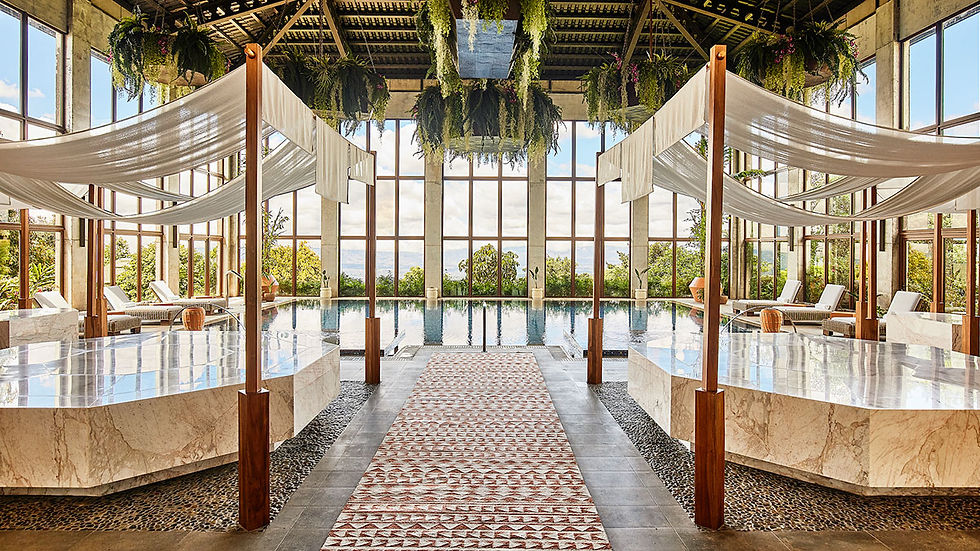Biophilic Tourism: The Fusion of Nature, Wellness & Certification
- The Jenny B Project
- Jul 25
- 4 min read
🌿 Biophilic Tourism: The Fusion of Nature, Wellness & Certification
In today’s travel landscape, biophilic tourism—which weaves natural elements into destination design—is shaping the future of wellness-oriented travel. With global wellness tourism expected to exceed $1 trillion by 2025 (Vogue Business), travelers increasingly demand environments that nurture health and environmental harmony. Achieving WELL and LEED certifications helps resorts, hotels, and wellness destinations credibly deliver on this promise.

Wellness Tourism Growth & Demand
Wellness tourism is exploding—valued at ~$830 billion in 2023, and projected to rise to $1.7 trillion by 2025 (Global Wellness Institute). Accommodation remains the primary sector, accounting for ~23% of wellness revenue (Wikipedia). Travelers are looking not just for spa services, but for immersive environments that support sustainable well-being.
WELL Certification: Prioritizing Human Health & Connection to Nature
The WELL Building Standard®, developed by IWBI, puts human health front and
center. It includes explicit biophilic metrics under its Mind concept, emphasizing natural lighting, indoor plants, water features, and organic materials as core health features (Biofiliate).
Studies show WELL-certified spaces deliver measurable improvements in stress reduction, cognitive function, and occupant satisfaction. By embracing biophilic elements, hospitality designs better support mental well-being—making wellness tourism a natural application.
LEED Certification: Anchoring Biophilic Strategy in Sustainability
LEED (Leadership in Energy and Environmental Design) is a globally recognized standard for sustainable building performance. Although it doesn’t explicitly mandate biophilia, many of its credit categories strongly align with biophilic design—such as Natural Ventilation, Daylighting, Green Roofs, Living Walls, and Sustainable Materials (Biofiliate).
Biophilic strategies can contribute to a range of LEED v5 credits, including Occupant Experience, Adaptation for Neurodiversity, and Innovation in Design (Benholm). Studies suggest that this ecological-personal health synergy may warrant integrating the two systems into a unified certification in the future (Taylor & Francis).
The Research Link: Measurable Wellness Impacts & Financial Benefits

Physiological benefits: Exposure to indoor plants and nature views has been shown to lower blood pressure, reduce stress, and even improve pain tolerance and recovery (Wikipedia).
Economic upside: Cornell’s hospitality research found that LEED-certified hotels outperform on occupancy and daily rates compared to non-certified peers (Terrapin Bright Green). Another study confirmed that rooms with nature views regularly command premium pricing.
Biophilia in hospitality settings: Initial work by Terrapin Bright Green (in partnership with Interface and Gensler) is exploring how biophilic design affects guest experience and revenue in hospitality—even though hard data remains emerging (Terrapin Bright Green).
Exemplary Case Studies
🏔️ Vermejo’s Costilla Fishing Lodge (New Mexico)
Set 10,200 ft high in wilderness, this LEED Silver lodge integrates solar power, locally milled timber, radiant heating, and recycled materials, all while preserving native land and wildlife habitat—demonstrating sustainable luxury in remote landscapes (Architectural Digest).
🌿 Coeur d’Alene Resort Expansion
Part of Terrapin’s hospitality case studies: the lodge’s design weaves local ecology and tribal culture into the guest experience. Green roofs, sensory stimuli, and natural materials create restorative environments linked to tribal lands and landscape (Terrapin Bright Green).
Why WELL + LEED = Biophilic Tourism Success
Dimension | WELL Focus | LEED Focus | Biophilic Benefit |
Human Health | Direct occupant experience, daylight, plant life, air quality | Indoor environmental quality, ventilation, material health | Enhances well-being and stress reduction |
Sustainability | Low-emission materials, circadian lighting | Energy/PV, water conservation, biodiversity, green roofs | Reduces carbon, preserves ecosystems |
Design & Marketability | Guest wellness branding, sensory design | Certification credibility, cost savings, economic performance | Attracts wellness travelers and commands premium |
Innovation | Biophilic programming & mindful spaces | Inclusive design credits, innovation pathways | Inclusive environments for all users |
Integrating both standards supports holistic, regenerative tourism experiences.
Challenges & Opportunities
Budget & Coordination: Aligning biophilic design with both WELL and LEED can increase upfront costs; however, long-term payback through energy savings and guest loyalty often justifies the investment (Taylor & Francis, self.com, Plant Plan, Biofiliate, ArchDaily, Vogue Business, HR Fraternity).
Space Limitations: Urban resorts or hotels may struggle to integrate gardens or green walls. Vertical green features and rooftop gardens become key strategies, especially where local codes mandate or encourage these features (Biofiliate).
Regulatory Complexity: In dense cities like NYC, integrating WELL + LEED can be challenged by local design codes (e.g. Local Law 92) and zoning constraints—still, projects like The Spiral and Google’s Chelsea campus show it can be done successfully (Biofiliate).
Looking forward, WELL and LEED aligned with biophilic design principles will continue to support a new generation of tourism: places that prioritize nature‑rich, healthy, and sustainable experiences.
The Future of Biophilic Tourism
Increasing traveller interest in restorative, authentically nature-connected experiences fuels the rise of biophilic tourism. WELL certification ensures guest wellness, LEED grounds projects in environmental stewardship—and together they create destinations that are good for people and good for planet.
As wellness travelers favor higher-value, multiperceptual experiences, destinations embracing biophilia with certified credibility stand out. Expect to see more resorts, mountain lodges, villas, and even urban hotels integrating these standards into tourism design strategies.
Biophilic tourism powered by WELL & LEED offers a compelling framework: bridging human wellness, environmental responsibility, and authentic design. It’s not just about green buildings or spa treatments—it’s about elevating travel experiences to a level where restorative nature, wellness, and sustainability coalesce.





Comments